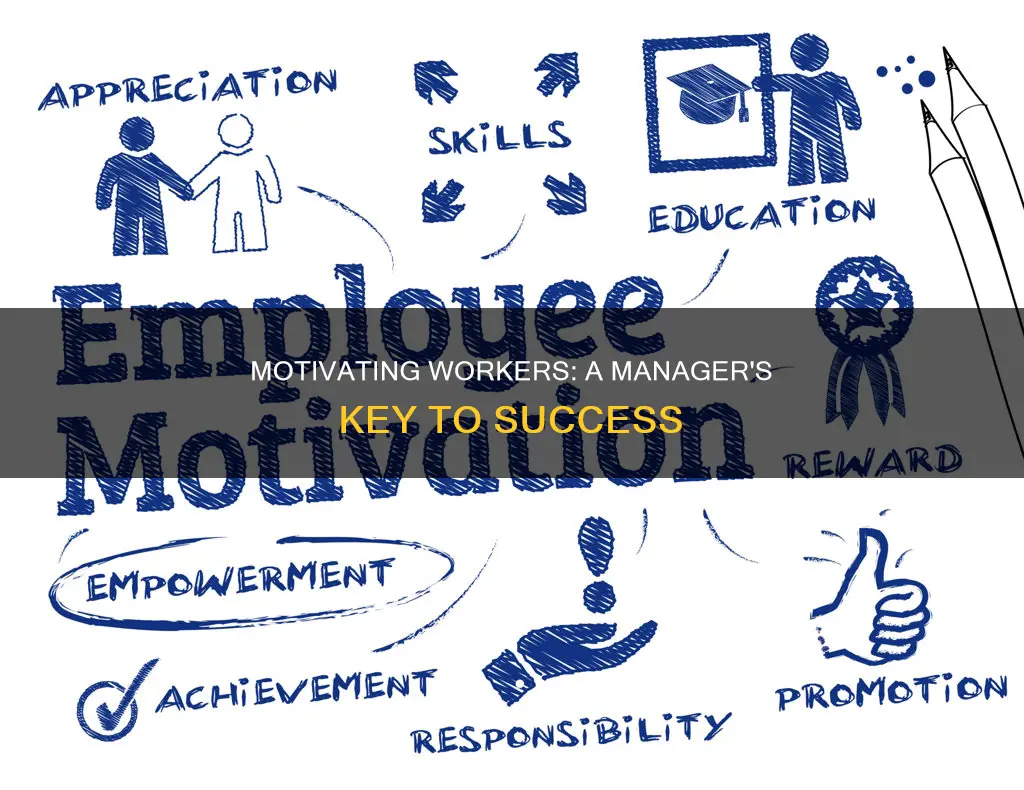
Motivating employees is an essential aspect of leadership and management. Leaders play a crucial role in inspiring their team to work hard and achieve their goals. By understanding their employees' needs, providing resources, and recognising their accomplishments, leaders can create a positive and productive work environment.
Investing time in employee motivation has numerous benefits for both the individual and the organisation. It boosts creativity and generates new ideas, improves company culture and employee satisfaction, increases productivity, enhances customer service, and helps attract and retain top talent.
Leaders who effectively motivate their employees will see improved performance and results, contributing to the success of the business.
What You'll Learn

Understanding what motivates each employee
To understand what motivates each employee, managers must take the time to meet with each employee individually to discuss their work-related goals. This demonstrates a sincere interest in their lives and can help align work goals with employee goals.
- Learn about their personal goals: Showing interest in an employee's personal goals can help empower them to succeed in their professional roles.
- Provide mentorship opportunities: Mentorship programs can help employees set more advanced goals and motivate them to work harder.
- Offer career advancement opportunities: Employees who can visualise a future within the company are more likely to invest time and energy in their current roles.
- Promote team-building: Fun and rewarding team-building activities can boost morale and motivation, creating a sense of camaraderie and a collaborative work environment.
- Encourage innovation: Stimulating creativity and problem-solving can motivate employees to seek innovative solutions and improve their daily tasks.
- Provide regular feedback: Feedback sessions clarify expectations and goals, providing a clear roadmap for success.
- Involve employees in decision-making: When employees are actively engaged in shaping their work environment, they feel more committed and motivated to perform at their best.
- Promote a healthy work-life balance: A balanced lifestyle improves mental and physical health, leading to more focused, motivated, and resilient employees.
By understanding what motivates each employee, managers can tailor their support and guidance to create a thriving and engaged workforce.
Forestry Managed Investment Schemes: How Do They Work?
You may want to see also

Combining work goals with employee goals
Understanding Employee Motivators
Firstly, it is essential to recognise that different employees are motivated by different factors. Some may be driven by financial incentives, such as raises, bonuses, or promotions, while others may value praise, work-life balance, or job security. As a leader, it is important to take the time to understand what motivates each individual employee. This can be achieved through one-on-one discussions, motivation assessment tools, or surveys.
Setting Clear and Aligned Goals
Once you understand your employees' motivations, you can set clear and specific goals that align with both their aspirations and the organisation's objectives. Utilise the SMART (Specific, Measurable, Attainable, Relevant, Time-bound) framework to set goals that are realistic and achievable. Ensure that employees understand how their goals fit into the broader context of the company's mission and long-term vision.
Providing Mentorship and Growth Opportunities
Creating a culture of mentorship and growth can effectively combine work goals with employee goals. Offer mentorship programs where experienced colleagues can guide and support less senior staff. This not only helps employees develop new skills and knowledge but also provides a platform for them to pursue their career aspirations within the organisation.
Encouraging Autonomy and Ownership
Allow employees to have a say in their work and provide them with the autonomy to make decisions. This fosters a sense of ownership and makes them feel more connected to their jobs. Delegate tasks with clear guidelines and expectations, and always offer support and guidance when needed.
Performance Feedback and Recognition
Regular feedback is essential to keep employees motivated and on track with their goals. Provide both positive reinforcement and constructive criticism to help them understand their strengths and areas for improvement. Additionally, recognise and celebrate their achievements, whether through formal recognition programs or simple expressions of gratitude.
Creating a Positive Work Environment
Foster a positive, collaborative, and supportive work environment. Encourage open communication, where employees feel comfortable sharing their thoughts, concerns, and ideas. Lead by example by embodying qualities such as empathy, adaptability, and integrity. Use positive language in your communication to make employees feel valued and appreciated.
By implementing these strategies, leaders and managers can effectively combine work goals with employee goals, resulting in a motivated, engaged, and productive workforce.
Becoming an Investment Manager: South Africa's Guide
You may want to see also

Leading by example and being fair
Leading by Example:
- Self-Awareness and Continuous Learning: Effective leaders are self-aware and recognise their limitations, constantly seeking to improve and learn. This involves identifying areas for growth and prioritising development opportunities. By doing so, leaders set an example for their team, encouraging a culture of continuous improvement and learning.
- Integrity and Alignment: Leaders with integrity demonstrate alignment between their values and actions, earning the trust of their team members. This inspires employees to embody company values and prevents cynicism and disengagement.
- Decisive Communication: Motivational leaders communicate with purpose and stand by their decisions. They are quick to condemn behaviours that contradict company values and always refer back to these values when making tough choices. This decisiveness inspires confidence in their teams.
Being Fair:
- Open and Honest Communication: Transparency and honesty are essential for building trust with employees. Leaders should openly communicate the company's goals, challenges, and each team member's role in achieving success. This helps employees understand their value and how they contribute to the bigger picture.
- Recognition and Reward: Acknowledging and appreciating employee achievements, whether through a simple "thank you" or an employee-of-the-month award, reinforces a sense of worth and encourages dedication. Fair and unbiased recognition boosts morale and motivates employees to strive for excellence.
- Work-Life Balance: Creating a healthy work-life balance for employees is crucial for their overall happiness and motivation. This can be achieved by encouraging breaks, offering flexible scheduling for appointments and self-care, and providing remote work options to reduce commute times and increase productivity.
- Career Development Opportunities: Providing opportunities for career development and advancement is essential for employee motivation. Offering free on-the-job training, certification courses, and mentorship programs shows your commitment to their growth and helps them feel valued.
By leading by example and being fair, leaders and managers can foster a positive and supportive work environment, increase employee satisfaction and retention, and ultimately drive business success.
Strategies to Recover from a Drop in Your Investment Portfolio
You may want to see also

Keeping communication lines open
Honest and transparent communication is key to building trust with your employees. This can improve employee engagement, innovation, and productivity. It shows that you are willing to listen to their concerns and that they can share their honest thoughts without fear of retribution.
- Encourage your team to share their thoughts, concerns, and ideas.
- Give them time during team meetings to voice their opinions.
- Actively listen to what they have to say and acknowledge their input.
- Make it clear that their opinions matter.
- Share relevant company information with your team when appropriate. This may include financial updates, new projects, and long-term strategies.
- Be open to feedback and be willing to adapt your approach based on their input.
By fostering honest and open communication, you will create a culture of trust and engagement, leading to higher motivation and productivity among your team members.
AXA Investment Managers: Who Are They?
You may want to see also

Creating a positive work environment
- Encourage open communication: Foster an environment where team members feel comfortable expressing their thoughts, concerns, and ideas. This builds trust, improves engagement, and enhances innovation within the team.
- Set clear goals and expectations: Utilize the SMART goal-setting framework (Specific, Measurable, Achievable, Relevant, and Time-bound) to provide a clear direction for employees. This helps them stay focused and motivated while also reducing ambiguity and uncertainty.
- Recognize and reward employees: Establish a culture that values and acknowledges the efforts and accomplishments of team members. This can be done through personalized thank-you notes, celebrating milestones, or providing incentives such as bonuses or paid time off.
- Offer mentorship opportunities: Implement mentorship programs to promote both personal and professional development. This not only helps employees gain valuable insights and guidance but also empowers them to take on new challenges and set more advanced goals.
- Lead by example: As a leader, it is essential to embody qualities such as involvement, adaptability, empathy, and active listening. Leading by example creates a culture of integrity, dedication, and accountability, inspiring employees to emulate these positive behaviours.
- Allow for autonomy: Give employees a sense of ownership over their work by delegating tasks and allowing them to make decisions. This fosters a sense of connection to their jobs, boosts their confidence, and makes them eager to tackle new challenges.
- Prioritize diversity, equity, and inclusion (DEI) initiatives: Create an inclusive environment where all team members feel valued and respected, regardless of their backgrounds. This not only increases motivation but also makes your organization more attractive to a diverse talent pool.
- Provide growth and advancement opportunities: Help employees set and achieve their career goals by offering promotions, training, and mentorship within the organization. This demonstrates a commitment to their professional development, increasing their engagement and dedication to the company.
- Promote team-building activities: Organize fun and rewarding team-building activities to boost morale, enhance collaboration, and reduce conflicts within the team. Tailor these activities to the specific needs and interests of your team, ensuring inclusivity and participation for all members.
- Advocate for competitive compensation: Ensure that employees are compensated fairly and competitively. This fosters a sense of loyalty and motivates individuals to stay with the organization. Work with HR to advocate for fair pay practices and address any discrepancies in compensation.
- Encourage innovation: Stimulate creativity and problem-solving by providing opportunities for employees to explore innovative ideas and collaborate across different functions. Organize design thinking workshops, cross-functional collaborations, and continuous learning sessions to spark innovation.
- Provide regular and constructive feedback: Schedule regular one-on-one meetings to offer specific and timely feedback. Focus on behaviours and outcomes rather than personal traits, and keep comprehensive records of these sessions for accountability and continuous improvement.
- Involve employees in decision-making: Encourage employees to actively participate in shaping their work environment and processes. This can be done through suggestion boxes, surveys, or involving them in pilot initiatives. This fosters a sense of respect for their expertise and insights, motivating them to perform at their best.
- Promote a healthy work-life balance: Help employees maintain a balanced lifestyle by offering flexible scheduling, remote work options, or compressed workweeks. Encourage them to set boundaries and unplug from work during non-working hours. Additionally, implement wellness programs to support their physical and mental health.
By implementing these strategies, leaders and managers can create a positive work environment that motivates employees, enhances productivity, and contributes to the overall success of the organization.
Our Social Security Savings: Where Are They Invested?
You may want to see also
Frequently asked questions
A motivated workforce is more productive, has higher job satisfaction, and achieves better outcomes for the business. Motivated employees are also more likely to be creative, take ownership of their tasks, and use resources efficiently.
Motivated employees are more likely to provide better customer service, which leads to higher customer satisfaction and a positive brand image.
Higher motivation leads to lower absenteeism and staff turnover. By investing in employee motivation, companies can retain top talent, reduce hiring costs, and focus on developing the skills of their current staff.
Leaders play a crucial role in understanding employee needs, providing resources, and recognizing accomplishments. They should create a positive work environment, set clear goals, offer rewards, and encourage employee autonomy.
Leaders should demonstrate a commitment to employee happiness, provide opportunities for employees to speak up, and set an example worth following. They should also distribute work assignments appropriately, dedicate time to investing in their team, and prioritize coaching and mentoring.







